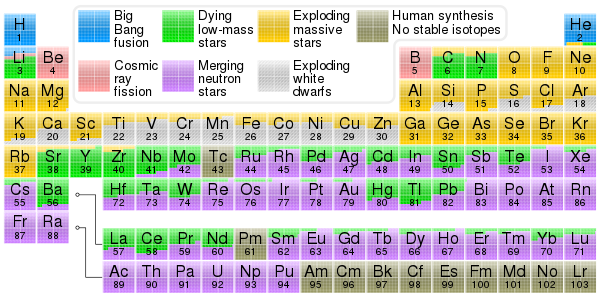CHON
CHON is a mnemonic acronym for the four most common elements in living organisms: carbon, hydrogen, oxygen, and nitrogen.
The acronym CHNOPS, which stands for carbon, hydrogen, nitrogen, oxygen, phosphorus, sulfur, represents the six most important chemical elements whose covalent combinations make up most biological molecules on Earth.[1] All of these elements are nonmetals.
| Element | Mass in plants | Mass in animals | Biological uses |
|---|---|---|---|
| Carbon | 12% | 19% | Found in carbohydrates, lipids, nucleic acids, and proteins. |
| Hydrogen | 10% | 10% | Found in carbohydrates, lipids, nucleic acids, and proteins. |
| Nitrogen | 1% | 4% | Found in nucleic acids and proteins. |
| Oxygen | 77% | 63% | Found in carbohydrates, lipids, nucleic acids, and proteins. |
| Phosphorus | <1% | <1% | Found in lipids and nucleic acids. |
| Sulfur | <1% | <1% | Found in proteins. |
In the human body, these four elements compose about 96% of the weight, and major minerals (macrominerals) and minor minerals (also called trace elements) compose the remainder.[2]
Sulfur is contained in the amino acids cysteine and methionine.[3] Phosphorus is contained in phospholipids, a class of lipids that are a major component of all cell membranes, as they can form lipid bilayers, which keep ions, proteins, and other molecules where they are needed for cell function, and prevent them from diffusing into areas where they should not be. Phosphate groups are also an essential component of the backbone of nucleic acids (general name for DNA & RNA) and are required to form ATP – the main molecule used as energy powering the cell in all living creatures.[4]
Carbonaceous asteroids are rich in CHON elements.[5] These asteroids are the most common type, and frequently collide with Earth as meteorites. Such collisions were especially common early in Earth's history, and these impactors may have been crucial in the formation of the planet's oceans.[6]
The simplest compounds to contain all of the CHON elements are fulminic acid and isocyanic acid (the latter of which is much more stable), having one of each atom.
See also[]
| Wikimedia Commons has media related to CHNOPS. |
References[]
- ^
Education (2010). "CHNOPS: The Six Most Abundant Elements of Life". Pearson Education. Pearson BioCoach. Retrieved 10 December 2010.
Most biological molecules are made from covalent combinations of six important elements, whose chemical symbols are CHNOPS. ... Although more than 25 types of elements can be found in biomolecules, six elements are most common. These are called the CHNOPS elements; the letters stand for the chemical abbreviations of carbon, hydrogen, nitrogen, oxygen, phosphorus, and sulfur.
- ^ "Atoms & Life". 27 September 2009.
- ^ Brosnan JT, Brosnan ME (June 2006). "The sulfur-containing amino acids: an overview". The Journal of Nutrition. 136 (6 Suppl): 1636S–1640S. doi:10.1093/jn/136.6.1636S. PMID 16702333.
- ^ Campbell, Neil A.; Brad Williamson; Robin J. Heyden (2006). Biology: Exploring Life. Boston, Massachusetts: Pearson Prentice Hall. ISBN 0-13-250882-6.
- ^ Water vs. Rocks: Resources for Earth or for Exploration? Archived 17 October 2012 at the Wayback Machine SSI-TV video archive, recorded on 30 October 2010, 66:07, four talks and Q&A given during Session 2: Extraterrestrial Prospecting of the Space Studies Institute’s Space Manufacturing 14 conference in California. Prof. Michael A'Hearn (University of Maryland) @ 7:10 in the video. The video also includes Brad Blair, Space Studies Institute, and Prof. Leslie Gertsch, University of Missouri-Rolla: Mining Concepts Development for Accessing Asteroid Resources; Mark Sonter, Asteroid Enterprises Pty Ltd Resources: Asteroids: What We Can Expect From What We Know Now; Dr. Faith Vilas, University of Arizona, Department of Astronomy and Steward Observatory, Retrieved 2011-01-07.
- ^ Morbidelli, A.; et al. (November 2000), "Source regions and time scales for the delivery of water to Earth", Meteoritics & Planetary Science, 35 (6): 1309–1320, Bibcode:2000M&PS...35.1309M, doi:10.1111/j.1945-5100.2000.tb01518.x
External links[]
| Look up CHON or CHNOPS in Wiktionary, the free dictionary. |

- Astrobiology
- Biology and pharmacology of chemical elements
- Mnemonic acronyms
- Science mnemonics
- Science fiction themes
- Astrochemistry
